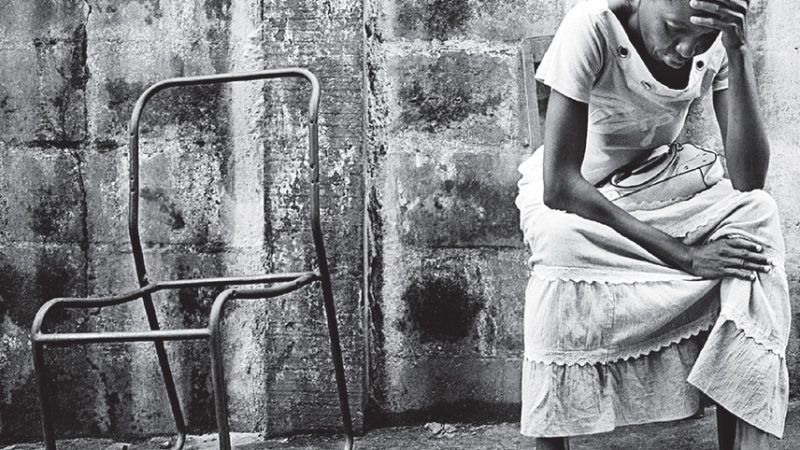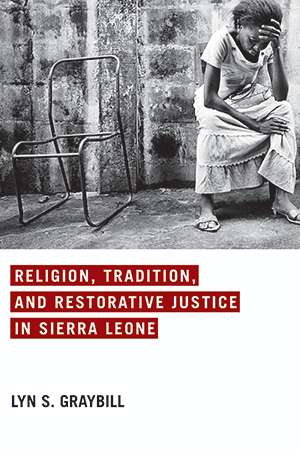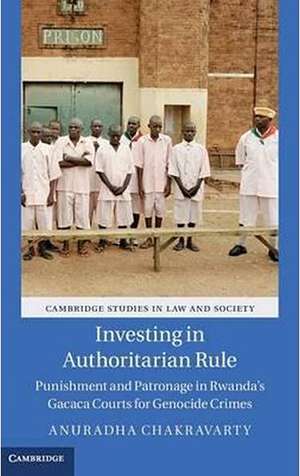Justice in the Wake of Civil War: Sierra Leone and Rwanda

Religion, Tradition, and Restorative Justice in Sierra Leone, by Lyn S. Graybill, University of Notre Dame Press, 301 pages, $45
Investing in Authoritarian Rule: Punishment and Patronage in Rwanda's Gacaca Courts for Genocide Crimes, by Anuradha Chakravarty, Cambridge University Press, 367 pages, $99.99

More than 40 civil wars have been waged in postcolonial Africa. Some never end. Others—Libya, South Sudan—restart after brief lulls. The results are devastating: crumpled infrastructure, blighted agriculture, declining investment, increasing misery. Populations have been uprooted and traumatized; combatants have committed barbaric acts. How do you pursue justice after a war finally concludes?
Two options are available. Western jurisprudence tends to stress punishing the guilty. Traditional African jurisprudence tends to emphasize reconciliation, restitution, and the restoration of social harmony. The first path is retributive, the second restorative. Two well-researched and magnificently written books on the experiences of Sierra Leone and Rwanda grapple with each approach.
In both countries, the relatively restorative option was far more cost-effective. In Sierra Leone, the Truth and Reconciliation Commission (TRC) cost $5 million, while the retributive Special Court for Sierra Leone (SCSL) ran $300 million a year. In Rwanda, the traditional restorative gacaca courts spent $40 million trying nearly 2 million cases over a decade. Compare that to the yearly $300 million price tag for the retributive International Tribunal for Rwanda, which completed fewer than 100 cases in two decades.
But despite its cost advantages, restorative justice can also be abused, particularly when the state controls how it is dispensed. Lyn S. Graybill's Religion, Tradition, and Restorative Justice in Sierra Leone comes down in favor of restorative justice in general, but it also shows how the government can botch its implementation; the country saw much better results when independent elements of civil society created their own restorative systems. In Investing in Authoritarian Rule, Anuradha Chakravarty reveals that the Rwandan government exploited the traditional system of justice for political purposes, using it to dole out favors and to extract acquiescence from a terrified population.

Sierra Leone's war began on March 23, 1991, when Foday Sankoh's rebel group, the Revolutionary United Front, invaded from Liberia. Sankoh's group was infamous for amputating the limbs of anyone, even babies, who seemed to stand in its way to power. When the war concluded 11 years later, some 75,000 civilians had been killed, 20,000 had been mutilated, and 2 million people were displaced.
To pursue justice afterward, both African and Western systems were deployed. The United Nations established the SCSL to prosecute the perpetrators of crimes against humanity. The government of Sierra Leone set up the Truth and Reconciliation Commission—modeled after a similar institution in post-apartheid South Africa—for lesser crimes.
Traditional African jurisprudence, practiced in different forms by around 2,000 ethnic groups, dates to pre-colonial times. It typically involves a public hearing where the culprit faces his victim, asks for forgiveness, and makes restitution. Some ethnic groups also require the culprit to perform rituals to "cleanse" himself before being readmitted to the community.
Graybill demonstrates that Sierra Leone's TRC, established to apply traditional African jurisprudence, was fatally flawed. Unnecessarily centralized in Freetown, the country's capital, it devoted only one week of hearings to provincial towns. Needless to say, rural villagers did not embrace the commission, dismissing it as a "foreign institution" that never really reached them. It also laid an excessive emphasis on individual victims. (During the war, whole families were killed, making it pointless to seek atonement for individual members.) Worse, the government ignored most of the commission's recommendations. In particular, reparations were not paid.
But that wasn't the end of the story. After the TRC folded in 2004, John Caulker, founder of the group Forum of Conscience, decided to try to heal the wounds of war at the local level. Accordingly, he developed Fambul Tok—Krio for "family talk"—in 2008, drawing on Sierra Leone's tradition of discussing and resolving issues within the family circle. Efforts were organized in each of the 149 chiefdoms across the country. The process included truth-telling bonfires as well as a traditional cleansing ceremony.
This was far more successful. It became easier for women to testify, for example: 44 percent of the Fambul Tok testimonies in Freetown came from women, with 19 percent dealing with sexual violations. In the first five years, there were more than 155 Fambul Tok ceremonies in some 130 chiefdoms, with over 2,700 people testifying before 60,000 neighbors.
The participation rate was higher because people regarded the process as more authentic; that in turn enhanced the effectiveness of the reconciliation attempts. The culprit and the victim could be brought face-to-face before trusted relatives and elders in a non-acrimonious atmosphere. No government body had to be involved.
Fambul Tok wasn't just more successful than the Truth and Reconciliation Commission; it was more cost-effective too. Each ceremony cost $300.
In the Rwandan genocide of 1994, at least 800,000 people—mostly of the Tutsi ethnic group—were butchered, and as many as 250,000 women were raped. Afterward, more than 120,000 people were detained and accused of participating in the killings.
To deal with such an overwhelming number of perpetrators, the U.N. Security Council established the International Criminal Tribunal for Rwanda on November 8, 1994, in Arusha, Tanzania. The tribunal formally closed on December 31, 2015. During its two decades of work, it indicted only 93 people, issued 55 first-instance judgments and 45 appeal judgments, and heard from 3,000 witnesses.
It would have taken more than a century to try all of the accused, so the government turned to the traditional court system for help. The gacaca courts operated from 2002 to 2012—Rwanda's largest state-driven project of popular mobilization.
Traditionally, the gacaca courts were community-based efforts. Decisions were made within the village, with no involvement by the colonial or post-colonial government. But this time, as Chakravarty shows, every aspect was controlled by the ruling Rwanda Patriotic Front (RPF) regime. The courts were formalized and invested with a range of state-sanctioned powers, from authorizing arrests to deciding on verdicts and sentencing. The judges were elected by the community and tasked by the state with serving as inyangamugayo, or "individuals of integrity"—a radical departure from the customary gacaca, which was used in an informal way. Thus, they were transformed into a machine that dispensed patronage (including grants of clemency and opportunities for private gain) in exchange for confessions, loyalty, and acceptance of the status quo.
The courts had extensive reach: They were set up in every grassroots administrative unit across the country. Through them, the state required attendance, testimonies, apologies from defendants, pardons from survivors, and population transfers between communities, labor camps, and prisons. People were asked to submit self-incriminating confessions, to denounce their neighbors, and to judge their peers for little or no compensation. Particularly worrying were the re-education programs attached to the project. Ingando, for example, was ostensibly a program of peace training. It was actually misused to indoctrinate more than 90,000 Rwandans with the RPF ideology.
In 10 years, 12,000 local tribunals manned by 250,000 lay judges heard from more than a million individual Hutu regarding 1,958,634 cases of genocide-related crimes. About 93 percent of the people convicted were Hutu. This reinforced the Tutsi-dominated regime's official line that the genocidaires were all Hutu and the victims all Tutsi. But Hutu extremists also killed several thousand Hutu moderates for trying to work with or protect Tutsis. And near the end of the conflict, the RPF chased fleeing Hutus into refugee camps in Congo, massacring thousands—a bloody episode the regime would prefer to conceal.
By 2012, 1 in 3 adult Hutu had participated in the trials, as judges, witnesses, and defendants. In the process, Chakravarty writes, "thousands upon thousands of individual Hutu acted upon and enforced RPF rules, reinforcing the regime with their cooperation in exchange for reduced sentences, security guarantees, the possibility of private gains in the form of personal vengeance or economic windfalls, and opportunities to access public power and social prestige."
In this way, Rwanda's gacaca courts cemented authoritarian rule. Their 10-year operation generated support for the RPF regime and consolidated its prospects for survival. A decade of mass trials produced a patronage-driven relationship in which the interests of the citizen became tied to an elite with the discretionary power to grant or withdraw benefits at will. Chakravarty labels this authoritarian clientelism.
The gacaca program achieved other perverse objectives as well. It became a magnet for international support and shielded the regime from donor scrutiny. Furthermore, the massive number of convictions affirmed the government's claim that there was a credible threat to national security from within the general Hutu population, justifying state repression.
These two books offer cautionary lessons about the destructive effects of government control. African societies have operated their own traditional systems of justice for centuries. But those systems are far more likely to do good when rulers leave them alone.
This article originally appeared in print under the headline "Justice in the Wake of Civil War: Sierra Leone and Rwanda."


Show Comments (41)